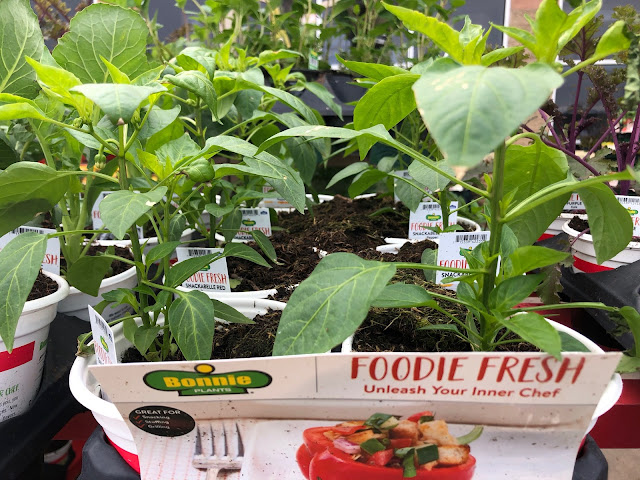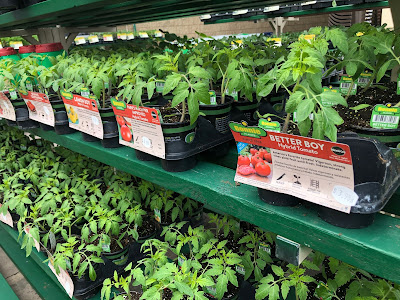
Vegetables do their best in the right conditions

|
|
Oh, these poor pepper plants, at a big-box store on Feb. 9. Note the flower buds already
on some of them. (Photos: Kathy Morrison)
|
There they were Tuesday, flats and flats of them, on shelves that were empty less than a week before: Snackabelle Red pepper plants. Most of them were 5 to 6 inches tall, and several already had flower buds.
Really? And February not even half over yet?
Across the aisle were many dozen tomato plants, apparently just off the truck, all the perfect size for transplanting. If only it were April. Or even late March.
It made my heart break to see them all.
These plants, even if they are purchased soon, are going to have rough, rough lives. When they go into the ground, their little roots are going to be so cold. The soil in my raised bed today is 52 degrees; the ground itself is even colder, 51. The roots are where the action is when a seedling is transplanted. They anchor the plant against wind and weather, and send nutrients and water up to the leaves, where the plant's food is made via photosynthesis.
Oh, yeah, there's not much sunlight out there right now, either. And we still have lows in the 30s in the forecast.
Now, if an experienced gardener really, really wanted to buy one of those Snackabelles right this second , he or she could bring it home, pot it up immediately, and put the container in the warmest outdoor spot in the garden, preferably under the eaves next to the house. Maybe even move the pot into the house. And then baby it until mid-spring, when UCCE Sacramento County master gardeners recommend planting out peppers. (See their great vegetable planting chart -- for both seeds and plants.)
But you know that's not going to happen because:
a) many experienced gardeners like to grow their peppers from seed, having started them in the past few weeks, or
b) they know they can buy fresh transplants at local nurseries in April, and/or
c) they have better things to do with their gardening time than babying a potted bell pepper through unpredictable weather.
So it will be inexperienced gardeners or impulse buyers who take home a few of those pepper plants. Then the plants -- newly moved from their cozy greenhouses to outdoors at a big-box store and then to someone's garden -- will just sit there for a long time, assuming we don't get any more frost. The stressed plants won't grow much, might drop their leaves and might be chomped by slugs or birds. The flower buds will fall off, too, unpollinated. Finally the owner will pull the plant out and go buy something else.

|
|
Some good tomato varieties here, but it's at least 6 weeks too
early to plant them in the Sacramento area. And 11 weeks until
our unofficial "tomato planting day," April 28. |
Moral of story: Just because a plant is offered for sale doesn't mean it's the right season or right climate to plant it. A little homework on planting will save any gardener a bucket of money.
Comments
0 comments have been posted.Sacramento Digs Gardening to your inbox.
Sites We Like
Garden Checklist for week of May 12
Get your gardening chores and irrigation done early in the day before temperatures rise.
* Plant, plant, plant! It’s prime planting season in the Sacramento area. Time to set out those tomato transplants along with peppers and eggplants. Pinch off any flowers on new transplants to make them concentrate on establishing roots instead of setting premature fruit.
* Direct-seed melons, cucumbers, summer squash, corn, radishes, pumpkins and annual herbs such as basil.
* Harvest cabbage, lettuce, peas and green onions. This heat will cause leafy greens and onions to flower; pick them before they bolt.
* In the flower garden, direct-seed sunflowers, cosmos, salvia, zinnias, marigolds, celosia and asters.
* Plant dahlia tubers. Other perennials to set out include verbena, coreopsis, coneflower and astilbe.
* Transplant petunias, marigolds and perennial flowers such as astilbe, columbine, coneflowers, coreopsis, dahlias, rudbeckia and verbena.
* Keep an eye out for slugs, snails, earwigs and aphids that want to dine on tender new growth.
* Feed summer bloomers with a balanced fertilizer.
* For continued bloom, cut off spent flowers on roses as well as other flowering plants.
* Got fruit trees? If you haven't already done so, thin orchard fruit such as apples, peaches, pears, pluots and plums before they grow too heavy, breaking branches or even splitting the tree. Leave the largest fruit on the branch, culling the smaller ones, and allow for 5 to 6 inches (or a hand's worth) between each fruit.
* Thin grape bunches, again leaving about 6 inches between them. For the remaining bunches, prune off the "tail" end, about the bottom third of the bunch, so that the plant's energy is concentrated in the fruit closest to the branch.
* As spring-flowering shrubs finish blooming, give them a little pruning to shape them, removing old and dead wood. Lightly trim azaleas, fuchsias and marguerites for bushier plants.
* Add mulch to the garden to help keep that precious water from evaporating. Mulch also cuts down on weeds. But don’t let it mound around the stems or trunks of trees or shrubs. Leave about a 6-inch to 1-foot circle to avoid crown rot or other problems.